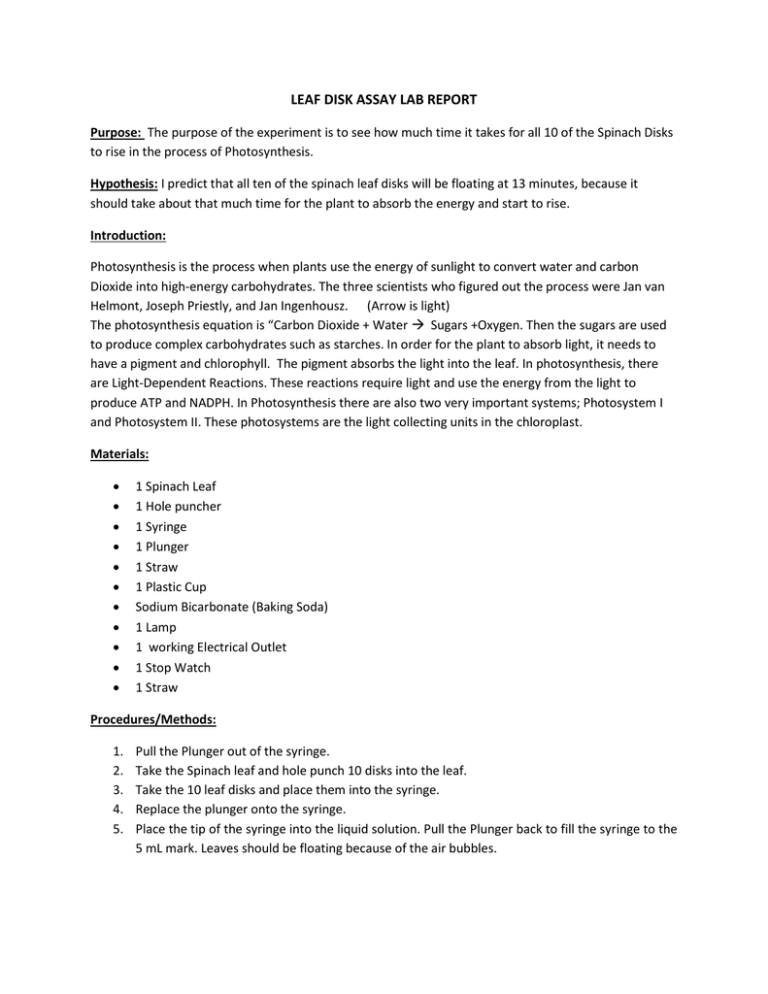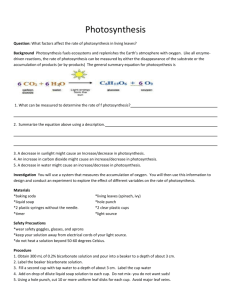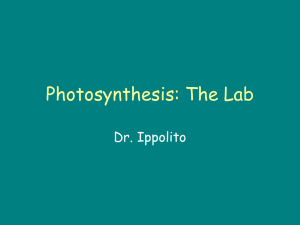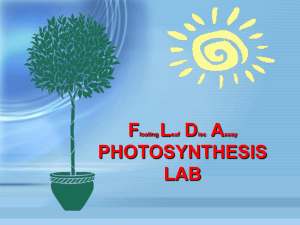leafdiskassaylabreport
advertisement

LEAF DISK ASSAY LAB REPORT Purpose: The purpose of the experiment is to see how much time it takes for all 10 of the Spinach Disks to rise in the process of Photosynthesis. Hypothesis: I predict that all ten of the spinach leaf disks will be floating at 13 minutes, because it should take about that much time for the plant to absorb the energy and start to rise. Introduction: Photosynthesis is the process when plants use the energy of sunlight to convert water and carbon Dioxide into high-energy carbohydrates. The three scientists who figured out the process were Jan van Helmont, Joseph Priestly, and Jan Ingenhousz. (Arrow is light) The photosynthesis equation is “Carbon Dioxide + Water Sugars +Oxygen. Then the sugars are used to produce complex carbohydrates such as starches. In order for the plant to absorb light, it needs to have a pigment and chlorophyll. The pigment absorbs the light into the leaf. In photosynthesis, there are Light-Dependent Reactions. These reactions require light and use the energy from the light to produce ATP and NADPH. In Photosynthesis there are also two very important systems; Photosystem I and Photosystem II. These photosystems are the light collecting units in the chloroplast. Materials: 1 Spinach Leaf 1 Hole puncher 1 Syringe 1 Plunger 1 Straw 1 Plastic Cup Sodium Bicarbonate (Baking Soda) 1 Lamp 1 working Electrical Outlet 1 Stop Watch 1 Straw Procedures/Methods: 1. 2. 3. 4. 5. Pull the Plunger out of the syringe. Take the Spinach leaf and hole punch 10 disks into the leaf. Take the 10 leaf disks and place them into the syringe. Replace the plunger onto the syringe. Place the tip of the syringe into the liquid solution. Pull the Plunger back to fill the syringe to the 5 mL mark. Leaves should be floating because of the air bubbles. 6. Place the tip of your index finger onto the tip of the syringe and pull the plunger back until you feel the vacuum pressure for 10 seconds. The vacuum pulls any air bubbles from the tissues of the Leaf Disks. 7. Slowly release the plunger. When you return the tip of your syringe upward, the leaf disks should start to sink. This process may need to be done several times to get all 10 of the leaf disks to sink. 8. After all 10 of the leaf disks have settled to the bottom, remove the stand and plunger and pour the disks and liquid into the plastic cup. The disks should sink to the bottom of the cup. 9. Attach the lamp to an electrical outlet and turn it on. 10. Place the cup under the lamp. The lamp should form a right angle. 11. Turn on the light and start timing. 12. Every minute record how many leaf disks are floating. 13. When all ten disks are floating, turn the light off and place the cup in the dark. 14. Every minute count how many of the disks are floating and stir gently with a straw, then return the cup back to the dark. Data/Results: Data Analysis: In this experiment, the first leaf started to float at four minutes. The 10th leaf floated up at 11 minutes. When all of the leaves were floating, they stayed for three minutes, meaning after taking the plastic cup out of the light, all of the disks still floated until 14 minutes, which was when the first leaf sunk. From there, the leaves gradually sunk. At 18 minutes, time was called and everyone had to clear the lab table. The lab was left incomplete, as for the fact that we had not seen when all of the leaves had sunk. At 18 minutes we had reached to the seventh leaf dropping and three leaves floating. Conclusion: In this experiment my hypothesis was rejected. I predicted that the 10th spinach disk would float up at 13 minutes, but the 10th leaf had already floated up at 11 minutes. I think my hypothesis was rejected because we had changed the amount of light for the cup by bringing the cup closer to the light. This means that when we had lifted the plastic cup to become closer to the light, then the speed of photosynthesis had been impacted. If we had kept the cup at a closer level the whole time, or have kept it at the level it was at before, then the results could have been more accurate.






